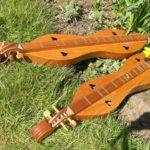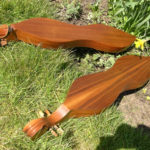Wilson Hourglass
Richard was a skilled carpenter but had to find a new career after the early 70s housing slump. His parents got him interested in the dulcimer and after building a kit, he and his wife decided to make their own. Early on, they had to choose between buying a sofa for their apartment and a bandsaw. They chose the latter, converting the living room into a workshop and living in the bedroom! Richard specialised in the acoustics and the construction, while his wife did the ornamentation (inlays and soundholes). Decorations included mother-of-pearl unicorns, sailboats and birds; soundholes ranged from hearts, seagulls to cherries. He estimated that each dulcimer took from 13 to 150 hours to make. Between 1974 and 1985 they claimed to have made over 2000 instruments, travelling from art fair to art fair across the country and selling them for between $110 and $1100.
The craftsmanship on this dulcimer is excellent – from the distinctive handcarved tapering scroll/pegbox to the elegant swirling heart soundholes. It has a well-proportioned, shallow walnut body, bookmatched on both back and top, a walnut one piece fingerboard and walnut endstock/pegbox. Even the handcarved pegs look like walnut. There is a floating bridge (rosewood or ebony). Can be set up for three or four course (equidistant) strings – BUT it is not possible to fit modern geared tuners. Overall length 35¼”, upper bout 5⅝”, lower bout 6½”, height 1¾”, FBW 1⅜”, VSL 28⅛” (longish scale), weight 1lb 7oz (659g). New 6½ fret fitted.
This is a very light and responsive dulcimer, with an easy action and good projection. It has a lighter tone emphasising the treble, as you would expect from a smaller instrument, but it is a great, complex sound with plenty of scope for player dynamics and good left hand technique. Relatively plain and un-ornamented, but handsomely proportioned and elegant, I really rate this as a classic dulcimer.


